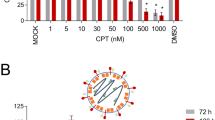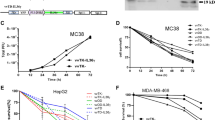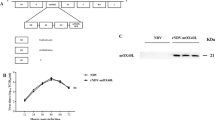Abstract
The canine parvovirus NS1 (CPV2.NS1) protein selectively induces apoptosis in the malignant cells. However, for an effective in vivo tumor treatment strategy, an oncolytic agent also needs to induce a potent anti-tumor immune response. In the present study, we used poly (I:C), a TLR3 ligand, as an adjuvant along with CPV2.NS1 to find out if the combination can enhance the oncolytic activity by inducing a potent anti-tumor immune response. The 4T1 mammary carcinoma cells were used to induce mammary tumor in Balb/c mice. The results suggested that poly (I:C), when given along with CPV2.NS1, not only significantly reduced the tumor growth but also augmented the immune response against tumor antigen(s) as indicated by the increase in blood CD4+ and CD8+ counts and infiltration of immune cells in the tumor tissue. Further, blood serum analysis of the cytokines revealed that Th1 cytokines (IFN-γ and IL-2) were significantly upregulated in the treatment group indicating activation of cell-mediated immune response. The present study reports the efficacy of CPV2.NS1 along with poly (I:C) not only in inhibiting the mammary tumor growth but also in generating an active anti-tumor immune response without any visible toxicity. The results of our study may help in developing CPV2.NS1 and poly (I: C) combination as a cancer therapeutic regime to treat various malignancies.







Similar content being viewed by others
References
Mincberg M, Gopas J, Tal J. Minute virus of mice (MVMp) infection and NS1 expression induce p53 independent apoptosis in transformed rat fibroblast cells. Virology. 2011;412(1):233–43.
Hristov G, Kramer M, Li J, El-Andaloussi N, Mora R, Daeffler L, Zentgraf H, Rommelaere J, Marchini A. Through its nonstructural protein NS1, parvovirus H-1 induces apoptosis via accumulation of reactive oxygen species. J Virol. 2010;84(12):5909–22.
Bar S, Rommelaere J, Nuesch JP. Vesicular transport of progeny parvovirus particles through ER and Golgi regulates maturation and cytolysis. PLoS Pathog. 2013;9:e1003605.
Nuesch JP, Rommelaere J. NS1 interaction with CKII alpha: novel protein complex mediating parvovirus-induced cytotoxicity. J Virol. 2006;80:4729–39.
Poole BD, Karetnyi YV, Naides SJ. Parvovirus B19- induced apoptosis of hepatocytes. J Virol. 2004;78(14):7775–83.
Gupta SK, Sahoo AP, Gandham RK, Rosh N, Saxena L, Singh A, Harish DR, Tiwari AK. Canine parvovirus NS1 induced apoptosis involves mitochondria, accumulation of reactive oxygen species and activation of caspases. Virus Res. 2016. doi:10.1016/j.virusres.2015.10.019.
Gupta SK, Yadav PK, Gandham RK, Sahoo AP, Singh A, Harish DR, Tiwari AK. Canine parvovirus NS1 protein exhibits anti-tumor activity in a mouse mammary tumor model. Virus Res. 2016. doi:10.1016/j.virusres.2015.12.017.
Gupta SK, Gandham RK, Sahoo AP, Tiwari AK. Viral genes as oncolytic agents for cancer therapy. Cell Mol Life Sci. 2015;72(6):1073–94.
Di Piazza M, Mader C, Geletneky K, Herrero Y, Calle M, Weber E, Schlehofer J, Deleu L, Rommelaere J. Cytosolic activation of cathepsins mediates parvovirus H-1-induced killing of cisplatin and TRAIL-resistant glioma cells. J Virol. 2007;81:4186–98.
Blachère NE, Darnell RB, ML A. Apoptotic cells deliver processed antigen to dendritic cells for cross-presentation. PLoS Biol. 2005;3(6):e185.
Guermonprez P, Valladeau J, Zitvogel L, Théry C, Amigorena S. Antigen presentation and T cell stimulation by dendritic cells. Annu Rev Immunol. 2002;20(1):621–67.
Festjens N, Vanden Berghe T, Vandenabeele P. Necrosis, a well-orchestrated form of cell demise: signalling cascades, important mediators and concomitant immune response. BBA Bioenerg. 2006;1757(9):1371–87.
Chen Z, Moyana T, Saxena A, Warrington R, Jia Z, Xiang J. Efficient antitumor immunity derived from maturation of dendritic cells that had phagocytosed apoptotic/necrotic tumor cells. Int J Cancer. 2001;93(4):539–48.
Santra L, Rajmani RS, Ravi Kumar GVPPS, Saxena S, Dhara SK, Kumar A, Sahoo AP, Singh LV, Desai GS, Chaturvedi U, Kumar S, Tiwari AK. Non-structural protein 1 (NS1) gene of canine parvovirus-2 regresses chemically induced skin tumors in Wistar rats. Res Vet Sci. 2014. doi:10.1016/j.rvsc.2014.07.024.
Llopiz D, Dotor J, Zabaleta A, Lasarte JJ, Prieto J, Borras-Cuesta F, et al. Combined immunization with adjuvant molecules poly(I:C) and anti-CD40 plus a tumor antigen has potent prophylactic and therapeutic antitumor effects. Cancer Immunol Immunother. 2008;57(1):19–29.
Gupta SK, Deb R, Chellappa MM, Dey S. Toll-like receptors based adjuvants enhancing the immune response to infectious diseases of chicken. Expert Rev Vaccines. 2014;13:909–25.
Gupta SK, Bajwa P, Deb R, Chellappa MM, Dey S. Flagellin A TLR5 agonist as an adjuvant in chicken vaccines. Clin Vaccine Immunol. 2014;21:261–70.
Akira S, Takeda K, Kaisho T. Toll-like receptors: critical proteins linking innate and acquired immunity. Nat Immunol. 2001;2(8):675–80.
Sato Y, Goto Y, Narita N, Hoon DS. Cancer cells expressing Toll-like receptors and the tumor microenvironment. Cancer Microenviron. 2009;2(1):205–14.
Zhou M, McFarland-Mancini MM, Funk HM, Husseinzadeh N, Mounajjed T, Drew AF. Toll-like receptor expression in normal ovary and ovarian tumors. Cancer Immunol Immunother. 2009;58(9):1375–85.
Cheng YS, Xu F. Anticancer function of polyinosinic–polycytidylic acid. Cancer Biol Ther. 2010;10(12):1219–23.
McBride S, Hoebe K, Georgel P, Janssen E. Cell-associated double-stranded RNA enhances antitumor activity through the production of type I IFN. J Immunol. 2006;177(9):6122–8.
Banz A, Cremel M, Mouvant A, Guerin N, Horand F, Godfrin Y. Tumor growth control using red blood cells as the antigen delivery system and poly(I:C). J Immunother. 2012;35(5):409–17.
Wick DA, Martin SD, Nelson BH, Webb JR. Profound CD8+ T cell immunity elicited by sequential daily immunizationwith exogenous antigen plus the TLR3 agonist poly(I:C). Vaccine. 2011;29(5):984–93.
Salem ML, Kadima AN, Cole DJ, Gillanders WE. Defining the antigenspecific T-cell response to vaccination and poly(I:C)/TLR3 signaling: evidence of enhanced primary and memory CD8 T-cell responses and antitumor immunity. J Immunother. 2005;28(3):220–8.
Cho HI, Barrios K, Lee YR, Linowski AK, Celis E. BiVax: a peptide/poly-IC subunit vaccine that mimics an acute infection elicits vast and effective anti-tumor CD8 T-cell responses. Cancer Immunol Immunother. 2013;62(4):787–99.
Currie AJ, van der Most RG, Broomfield SA, Prosser AC, Tovey MG, Robinson BW. Targeting the effector site with IFN-αβ-inducing TLR ligands reactivates tumor-resident CD8 T cell responses to eradicate established solid tumors. J Immunol. 2008;180(3):1535–44.
Cui Z, Le UM, Qiu F, Shaker DS. Learning fromviruses: the necrotic bodies of tumor cells with intracellular synthetic dsRNA induced strong anti-tumor immune responses. Pharm Res. 2007;24(9):1645–52.
Wang C, Zhuang Y, Zhang Y, Luo Z, Gao N, Li P, et al. Toll-like receptor 3 agonist complexed with cationic liposome augments vaccine-elicited antitumor immunity by enhancing TLR3–IRF3 signaling and type I interferons in dendritic cells. Vaccine. 2012;30(32):4790–9.
Babiarova K, Kutinova L, Zurkova K, Krystofova J, Brabcova E, Hainz P, et al. Immunization with WT1-derived peptides by tattooing inhibits the growth of TRAMP-C2 prostate tumor in mice. J Immunother. 2012;35(6):478–87.
Forghani P, Waller EK. Poly (I: C) modulates the immunosuppressive activity of myeloid-derived suppressor cells in a murine model of breast cancer. Breast Cancer Res Treat. 2015;153(1):21–30.
Wu CY, Yang HY, Monie A, Ma B, Tsai HH, Wu TC, Hung CF. Intraperitoneal administration of poly (I: C) with polyethylenimine leads to significant antitumor immunity against murine ovarian tumors. Cancer Immunol Immunother. 2011;60(8):1085–96.
Carlsson G, Gullberg B, Hafström L. Estimation of liver tumor volume using different formulas—an experimental study in rats. J Cancer Res Clin Oncol. 1983;105(1):20–3.
Yu CCW, Fletcher CD, Newman PL, Goodlad JR, Burton JC, Levison DA. A comparison of proliferating cell nuclear antigen (PCNA) immunostaining, nucleolar organizer region (AgNOR) staining, and histological grading in gastrointestinal stromal tumours. J Pathol. 1992;166(2):147–52.
Crocker J, Boldy DA, Egan MJ. How should we count AgNORs? Proposals for a standardized approach. J Pathol. 1989;158(3):185–8.
Doley J, Singh LV, Kumar GR, Sahoo AP, Saxena L, Chaturvedi U, Saxena S, Kumar R, Singh PK, Rajmani RS, Santra L, Palia SK, Tiwari S, Harish DR, Kumar A, Desai GS, Gupta S, Gupta SK, Tiwari AK. Canine parvovirus type 2a (CPV-2a)-induced apoptosis in MDCK involves both extrinsic and intrinsic pathways. Appl Biochem Biotechnol. 2014;172(1):497–508.
Moffatt S, Yaegashi N, Tada K, Tanaka N, Sugamura K. Human parvovirus B19 nonstructural (NS1) protein induces apoptosis in erythroid lineage cells. J Virol. 1998;72(4):3018–28.
Zhao D, Cai C, Wang Y, Xiao S, Zheng Q. Specific antigastric cancer effects of a recombinant plasmid expressing non-structural protein 1 of parvovirus H1. Saudi Med J. 2014;35(4):336–45.
Wang YY, Liu J, Zheng Q, Ran ZH, Salome N, Vogel M, Rommelaere J, Xiao SD, Wang Z. Effect of the parvovirus H-1 non-structural protein NS1 on the tumorigenicity of human gastric cancer cells. J Dig Dis. 2012b;13(7):366–73.
Lv D, Zhang Y, Kim HJ, Zhang L, Ma X. CCL5 as a potential immunotherapeutic target in triple-negative breast cancer. Cell Mol Immunol. 2013;10(4):303–10.
Markowitz J, Wesolowski R, Papenfuss T, Brooks TR, Carson III WE. Myeloid-derived suppressor cells in breast cancer. Breast Cancer Res Treat. 2013;140(1):13–21.
Martin F, Apetoh L, Ghiringhelli F. Role of myeloid-derived suppressor cells in tumor immunotherapy. Immunotherapy. 2012;4(1):43–57.
Zhang C, Lei GS, Shao S, Jung HW, Durant PJ, Lee CH. Accumulation of myeloid-derived suppressor cells in the lungs during pneumocystis pneumonia. Infect Immun. 2012;80(10):3634–41.
Younos IH, Dafferner AJ, Gulen D, Britton HC, Talmadge JE. Tumor regulation of myeloid-derived suppressor cell proliferation and trafficking. Int Immunopharmacol. 2012;13(3):245–56.
Terabe M, Matsui S, Park JM, Mamura M, Noben-Trauth N, Donaldson DD, et al. Transforming growth factor-beta production and myeloid cells are an effector mechanism through which CD1d-restricted T cells block cytotoxic T lymphocyte-mediated tumor immunosurveillance: abrogation prevents tumor recurrence. J Exp Med. 2003;198:1741–52.
Salvadori S, Martinelli G, Zier K. Resection of solid tumors reverses T cell defects and restores protective immunity. J Immunol. 2000;164:2214–20.
Kuhn S, Hyde EJ, Yang J, Rich FJ, Harper JL, Kirman JR, Ronchese F. Increased numbers of monocyte-derived dendritic cells during successful tumor immunotherapy with immune-activating agents. J Immunol. 2013;191(4):1984–92.
Salem ML, Diaz-Montero CM, El-Naggar SA, Chen Y, Moussa O, Cole DJ. The TLR3 agonist poly(I:C) targets CD8+ T cells and augments their antigen-specific responses upon their adoptive transfer into naive recipient mice. Vaccine. 2009;27(4):549–57.
Schmidt KN, Leung B, Kwong M, Zarember KA, Satyal S, Navas TA, et al. APC-independent activation of NK cells by the Toll-like receptor 3 agonist doublestranded RNA. J Immunol. 2004;172(1):138–43.
Lauzon NM, Mian F, MacKenzie R, Ashkar AA. The direct effects of Toll-like receptor ligands on human NK cell cytokine production and cytotoxicity. Cell Immunol. 2006;241(2):102–12.
Lion E, Anguille S, Berneman ZN, Smits EL, Van Tendeloo VF. Poly(I:C) enhances the susceptibility of leukemic cells to NK cell cytotoxicity and phagocytosis by DC. PLoS One. 2011;6(6):e20952.
Huang YK, Zheng Z, Qiu F. Polyinosinic–cytidylic acid as an adjuvant on natural killer- and dendritic cell-mediated antitumor activities. Tumour Biol. 2013;34(3):1615–23.
Muthuswamy R, Wang L, Pitteroff J, Gingrich JR, Kalinski P. Combination of IFNα and poly-I: C reprograms bladder cancer microenvironment for enhanced CTL attraction. J Immunother Cancer. 2015;3(1):1–10.
Zoglmeier C, Bauer H, Nörenberg D, Wedekind G, Bittner P, Sandholzer N, et al. CpG blocks immunosuppression by myeloid-derived suppressor cells in tumor-bearing mice. Clin Cancer Res. 2011;17(7):1765–75.
Bhoopathi P, Quinn BA, Gui Q, Shen XN, Grossman SR, Das SK, et al. Pancreatic cancer-specific cell death induced in vivo by cytoplasmic-delivered polyinosine–polycytidylic acid. Cancer Res. 2014.
Forte G, Rega A, Morello S, Luciano A, Arra C, Pinto A, Sorrentino R. Polyinosinic–polycytidylic acid limits tumor outgrowth in a mouse model of metastatic lung cancer. J Immunol. 2012;188(11):5357–64.
Inao T, Harashima N, Monma H, Okano S, Itakura M, Tanaka T, et al. Antitumor effects of cytoplasmic delivery of an innate adjuvant receptor ligand, poly (I: C), on human breast cancer. Breast Cancer Res Treat. 2012;134(1):89–100.
Jiang Q, Wei H, Tian Z. Poly I:C enhances cycloheximide-induced apoptosis of tumor cells through TLR3 pathway. BMC Cancer. 2008;8(1):12.
Green TL, Santos MF, Ejaeidi AA, Craft BS, Lewis RE, Cruse JM. Toll-like receptor (TLR) expression of immune system cells from metastatic breast cancer patients with circulating tumor cells. Exp Mol Pathol. 2014;97(1):44–8.
Folkman J (2003) Angiogenesis and apoptosis. In: Seminars in cancer biology. 13(2):159–67. Academic Press.
Yang L, DeBusk LM, Fukuda K, Fingleton B, Green-Jarvis B, Shyr Y, et al. Expansion of myeloid immune suppressor Gr + CD11b + cells in tumor-bearing host directly promotes tumor angiogenesis. Cancer Cell. 2004;6(4):409–21.
Murdoch C, Muthana M, Coffelt SB, Lewis CE. The role of myeloid cells in the promotion of tumour angiogenesis. Nat Rev Cancer. 2008;8(8):618–31.
Monu NR, Frey AB. Myeloid-derived suppressor cells and anti-tumor T cells: a complex relationship. Immunol Investig. 2012;41(6–7):595–613.
Bocchia M, Bronte V, Colombo MP, De Vincentiis A, Di Nicola M, Forni G, Lanata L, Lemoli RM, Massaia M, Rondelli D, Zanon P, Tura S. Antitumor vaccination: where we stand. Haematologica. 2000;85(11):1172–206.
Rosenberg SA, Yang JC, Restifo NP. Cancer immunotherapy: moving beyond current vaccines. Nat Med. 2004;10(9):909–15.
Heath WR, Carbone FR. Cross-presentation, dendritic cells, tolerance and immunity. Annu Rev Immunol. 2001;19(1):47–64.
Moehler MH, Zeidler M, Wilsberg V, Cornelis JJ, Woelfel T, Rommelaere J, Galle PR, Heike M. Parvovirus H-1-induced tumor cell death enhances human immune response in vitro via increased phagocytosis, maturation, and cross-presentation by dendritic cells. Hum Gene Ther. 2005;16(8):996–1005.
Albert ML, Pearce SFA, Francisco LM, Sauter B, Roy P, Silverstein RL, Bhardwaj N. Immature dendritic cells phagocytose apoptotic cells via avb5 and CD36, and crosspresent antigens to cytotoxic T lymphocytes. J Exp Med. 1998;188(7):1359–68.
Nüesch JP, Rommelaere J. Tumor suppressing properties of rodent parvovirus NS1 proteins and their derivatives. Anticancer genes. London: Springer; 2014. p. 99–124.
Ruf W, Disse J, Carneiro-Lobo TC, Yokota N, Schaffner F. Tissue factor and cell signalling in cancer progression and thrombosis. J Thromb Haemost. 2011;9(s1):306–15.
Han X, Guo B, Li Y, Zhu B. Tissue factor in tumor microenvironment: a systematic review. J Hematol Oncol. 2014;1(7):54.
Guo Z, Chen L, Zhu Y, Zhang Y, He S, Qin J, Tang X, Zhou J, Wei Y. Double-stranded RNA-induced TLR3 activation inhibits angiogenesis and triggers apoptosis of human hepatocellular carcinoma cells. Oncol Rep. 2012;27(2):396–402.
Wu J, Cui H, Dick AD, Liu L. TLR9 agonist regulates angiogenesis and inhibits corneal neovascularization. Am J Pathol. 2014;184(6):1900–10.
Kleinman ME, Yamada K, Takeda A, et al. Sequence- and target independent angiogenesis suppression by siRNA via TLR3. Nature. 2008;452:591–7.
Cho WG, Albuquerque RJ, Kleinman ME, et al. Small interfering RNA-induced TLR3 activation inhibits blood and lymphatic vessel growth. Proc Natl Acad Sci U S A. 2009;106:7137–42.
Paone A, Galli R, Gabellini C, Lukashev D, Starace D, Gorlach A, De Cesaris P, Ziparo E, Del Bufalo D, Sitkovsky MV, Filippini A. Toll-like receptor 3 regulates angiogenesis and apoptosis in prostate cancer cell lines through hypoxia-inducible factor 1α. Neoplasia. 2010;12(7):539–49.
Acknowledgments
The authors are thankful to the Director, Indian Veterinary Research Institute, Izatnagar-243 122, UP, India, for providing necessary facilities and National Agricultural Innovative Project (reference C4/C3001) for providing funding to carry out the work. We are also thankful to Dr. Rajendra Singh, Head, Division of Veterinary Pathology and to Dr. K.P. Singh for providing facilities to perform histopathology and immunohistochemistry.
Author information
Authors and Affiliations
Corresponding authors
Ethics declarations
The experiments were carried out as per the guidelines and approval of the Institute Animal Ethics Committee and Committee for the Purpose of Control and Supervision of Experiments on Animals (CPCSEA).
Conflicts of interest
None.
Rights and permissions
About this article
Cite this article
Gupta, S.K., Yadav, P.K., Tiwari, A.K. et al. Poly (I:C) enhances the anti-tumor activity of canine parvovirus NS1 protein by inducing a potent anti-tumor immune response. Tumor Biol. 37, 12089–12102 (2016). https://doi.org/10.1007/s13277-016-5093-z
Received:
Accepted:
Published:
Issue Date:
DOI: https://doi.org/10.1007/s13277-016-5093-z




